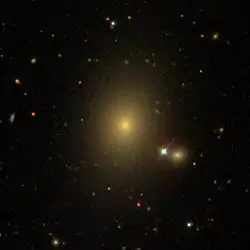| NGC 5223 | |
|---|---|
 SDSS image of NGC 5223 | |
| Observation data (J2000 epoch) | |
| Constellation | Canes Venatici |
| Right ascension | 13h 34m 25.243s[1] |
| Declination | +34° 41′ 25.53″[1] |
| Redshift | 0.024033[2] |
| Heliocentric radial velocity | 7205 km/s[2] |
| Distance | 291.91 ± 76.11 Mly (89.500 ± 23.335 Mpc)[2] |
| Apparent magnitude (B) | 14.4[3] |
| Characteristics | |
| Type | E[2] |
| Size | 160,000 ly (48,000 pc)[2][note 1] |
| Apparent size (V) | 1.5′ × 1.3′[2] |
| Other designations | |
| UGC 8553, MGC+06-30-040, PGC 47822[3] | |
NGC 5223 is an elliptical galaxy in the constellation of Canes Venatici.[2] It was discovered on 1 May 1785 by William Herschel.[4]
References
- 1 2 Skrutskie, Michael F.; Cutri, Roc M.; Stiening, Rae; Weinberg, Martin D.; Schneider, Stephen E.; Carpenter, John M.; Beichman, Charles A.; Capps, Richard W.; Chester, Thomas; Elias, Jonathan H.; Huchra, John P.; Liebert, James W.; Lonsdale, Carol J.; Monet, David G.; Price, Stephan; Seitzer, Patrick; Jarrett, Thomas H.; Kirkpatrick, J. Davy; Gizis, John E.; Howard, Elizabeth V.; Evans, Tracey E.; Fowler, John W.; Fullmer, Linda; Hurt, Robert L.; Light, Robert M.; Kopan, Eugene L.; Marsh, Kenneth A.; McCallon, Howard L.; Tam, Robert; Van Dyk, Schuyler D.; Wheelock, Sherry L. (1 February 2006). "The Two Micron All Sky Survey (2MASS)". The Astronomical Journal. 131 (2): 1163–1183. Bibcode:2006AJ....131.1163S. doi:10.1086/498708. ISSN 0004-6256. S2CID 18913331.
- 1 2 3 4 5 6 7 "NED results for object NGC 5223". National Aeronautics and Space Administration / Infrared Processing and Analysis Center. Retrieved 9 November 2017.
- 1 2 "NGC 5223". SIMBAD. Centre de données astronomiques de Strasbourg. Retrieved 9 November 2017.
- ↑ "New General Catalog Objects: NGC 5200 - 5249". cseligman.com. Retrieved 9 November 2017.
Notes
- ↑ r (SDSS Isophotal) values used.
External links
 Media related to NGC 5223 at Wikimedia Commons
Media related to NGC 5223 at Wikimedia Commons
This article is issued from Wikipedia. The text is licensed under Creative Commons - Attribution - Sharealike. Additional terms may apply for the media files.